Saint Sebastian
Sicilian (Trapanese) School
Category
Art / Sculpture
Date
c. 1650 - 1700
Materials
Alabaster
Measurements
1010 mm (Height)
Place of origin
Trapani
Order this imageCollection
Anglesey Abbey, Cambridgeshire
NT 516597
Summary
Alabaster, Saint Sebastian, Sicilian (Trapanese) School, c. 1650-1750. A large sculpture carved in alabaster and partly painted, depicting Saint Sebastian, a Roman soldier and Christian martyr, who was tormented by being shot with arrows. Made in Trapani in Sicily, c. 1650-1750. Saint Sebastian stands, naked except for a loincloth, bound to a tree, his eyes raised towards Heaven, his right foot upon his helmet. There are three holes in his body into which iron arrows were once fixed. The sculpture stands upon an elaborate base, also in alabaster, which has in between the foliate decoration military accoutrements such as a cuirass, a helmet and a drum. In the centre of the base is an openwork carved medallion depicting Sebastian, after he had been nursed back to health being brought before the Emperor.
Full description
This figure is an exceptionally large and fine example of the alabaster carvings that were produced in great numbers in workshops in Trapani, on the Western coast of Sicily, from the sixteenth century onwards, in part spurred by the demand for images of the miraculous Madonna di Trapani. The Jesuit Wilhelm Gumppenberg recorded in 1672 that there were around forty workshops in Trapani, the principal occupation of which was the production annually of around 5,000 small images of the Madonna of Trapani, mostly in alabaster (Guilielmus Gumppenberg, Atlas Marianus, Munich 1672, p. 120). Some of the workshops consisted of professional sculptors, some carvers in the city specialised in coral, whilst others worked in alabaster, coral and ivory. The Anglesey Abbey figure has been carved with greater care than is sometimes the case with Trapani alabasters, and is partly painted. There is extensive gold decoration on the base; on the ground on which Sebastian stands, and on the tree, may be seen painted leaf decoration and large gold dots. Sebastian’s loin cloth was partly painted and his hair is gilded, possibly renewed. Saint Sebastian was an immensely popular saint from the Medieval period onwards. Along with Saint Roch, he was one of the two principal saints prayed to for protection from the plague, which was an ever-present and deadly threat in cities and towns across Europe. He is usually shown, as here, in the process of being tormented for his faith, by having arrows shot into him. Little is known about the saint, who is said t have been an officer in the Praetorian Guard at the time of the Roman emperor Diocletian (A.D. 245-305, reigned 284-305). Sebastian was a secret Christian who, when two of his companions, Marcus and Marcellinus, were condemned to death for their Christian belief, stepped forward in their support. For this he was punished by being shot with arrows and was left for dead. However, Sebastian did not succumb to his wounds and is said to have been nursed back to health by a widow, Irene. He then confronted the Emperor with a renewed assertion of his faith, as seen in the small scene on the base. Sebastian was then beaten to death with clubs, and his body thrown into the main sewer of Rome, the Cloaca Maxima. Saint Sebastian was a popular subject with the Trapani carvers working in both ivory and alabaster. The alabastro rosa stone was especially well-suited to representations of the saint, since its roseate hue heightened the sense of realism in the standard depiction of the saint’s near-naked body, disfigured with arrow wounds. For example, a slightly smaller but otherwise comparable figure is in the collections at Burghley House (Inv. EWA 08682). The elaborate base is paralleled in the base for a figure of Saint Sebastian in the Museo Diocesano, Palermo (Maria Concetta Di Natale, ed., Materiali preziosi dalla terra e dal mare nell’arte trapanese e della Sicilia occidentale tra il XVIII e il XIX secolo, Palermo 2003, p. 258, no. V.10.3; Maria Concetta Di Natale, ed., Arti Decorativi nel Museo Diocesano di Palermo. Dalla città al museo e dal museo alla città, Palermo 1999, p. 17, fig. 2). The Saint Sebastian is the finest in an important group of alabaster carvings from Trapani at Anglesey Abbey. There is a small reduction of the Madonna di Trapani (NT 516604), a Nativity relief (NT 516581) and an extraordinary allegorical figure of Justice (NT 516591). Jeremy Warren 2020
Provenance
Acquired by Urban Huttleston Rogers Broughton, 1st Lord Fairhaven (1896-1966) from Barling, 111 Mount Street., London W1 on 22 July 1948 for £100; bequeathed to the National Trust by Lord Fairhaven (1896-1966) with the house and the rest of the contents
Credit line
Anglesey Abbey, The Fairhaven Collection (The National Trust)
Makers and roles
Sicilian (Trapanese) School, sculptor
References
Christie, Manson & Woods 1971: The National Trust, Anglesey Abbey, Cambridge. Inventory: Furniture, Textiles, Porcelain, Bronzes, Sculpture and Garden Ornaments’, 1971, p. 148, Upper Picture Gallery. Warren 2021: Jeremy Warren, ‘New perspectives on alabaster sculpture from Trapani‘, Colnaghi Studies Journal, Vol. 8 (March 2021), pp. 115-47





